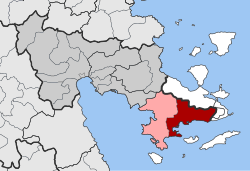Ermioni
|
Ermioni municipality Δημοτική Ενότητα Ερμιόνης (Ερμιόνη) |
||
|---|---|---|
|
|
||
| Basic data | ||
| State : |
|
|
| Region : |
Peloponnese
|
|
| Regional District : | Argolis | |
| Municipality : | Ermionida | |
| Geographic coordinates : | 37 ° 23 ' N , 23 ° 15' E | |
| Height above d. M .: | 7 m (average) |
|
| Area : | 168.18 km² | |
| Residents : | 4,099 (2011) | |
| Population density : | 24.4 inhabitants / km² | |
| Code No .: | 410402 | |
| Structure: |
1 city district 2 local communities |
|
| Located in the municipality of Ermionida and in the Argolis regional unit | ||
Ermioni ( Greek Ερμιόνη ( f. Sg. ), Ancient Greek Ἑρμιόνη Hermionē or Ἑρμιών Hermiōn , later also called Kastri ) is a small town in the Argolis landscape on the Peloponnese peninsula . Until 2010 it was an independent municipality; on January 1, 2011, it was merged with the neighboring town of Kranidi to form the new municipality of Ermionida , where it has since formed a municipality.
location
Ermioni is located in the northeast of the Peloponnese on the eastern slope of a rocky, partly wooded limestone ridge on the southeast coast of the Argolis opposite the island of Hydra . The area borders in the west on the municipality of Kranidi , in the north on the municipality of Trizinia-Methana, which belongs to the Attica region .
The current municipality of Ermioni consists of the localities (until 1997 independent municipalities)
- Ermioni, the seat of the former municipality with 3063 inhabitants. Ermioni is a tranquil place with chessboard-like streets, a small fishing port, the landing stage for the hydrofoils "Flying Dolphins" and several taverns.
- Iliokastro (558 inhabitants)
- Thermisia (479 inhabitants)
Thermisia is located on a lagoon - previously used for salt production - which is an important biotope as a resting place for migratory birds. Remains of a Venetian castle from the 12th century are located on a 350 m high cliff above the village.
The surrounding area is used for agriculture with citrus fruit and apricot plantations and olive groves.
history
Ancient Hermione ( ancient Greek Ἑρμιόνη , also Ἑρμιών ) was settled since the Bronze Age. It is already mentioned in Homer's Iliad in the ship catalog of ships participating in the Trojan War .
The city took part in the Persian Wars and is mentioned on the famous Serpent Column of Delphi . With three ships and land troops she also took part in the Peloponnesian War .
In the 4th and 5th centuries BC Hermione was mostly allied with Sparta . The total population is estimated for the 5th century BC. Estimated at 5000 to 7500 people. It joined the Achaean covenant in 229 BC . In addition to agriculture, fisheries and shipbuilding, purple fishing and the production of purple fabrics were economically important. Hermione minted its own coins and was inhabited at least in the 2nd century AD. This is evidenced by Pausanias , who describes the temples and larger buildings as well as various festivals and sporting competitions. In the following years, however, the place suffered from looting by pirates. However, it was still important for shipbuilding under the Turkish rule and therefore also played a role in the freedom struggles of 1821.
Today the remains of the city wall and a round tower are visible on a headland, as well as the foundations of a temple (possibly of Poseidon).
Economy and Transport
Ermioni is connected to the cities of the Argolida by land, but in particular has regular fast shipping connections; Several times a day hydrofoils, the so-called Flying Dolphins , go to the tourist islands of Hydra , Spetses , Poros and Aegina and to Piraeus . Driving time to Piraeus is around two hours.
The sandy beaches and the proximity to the tourist attractions of Hydra and Spetses, which are easily accessible by sea, have given a boost to tourist development. A large hotel and holiday apartment complex has been built at Thermisia under the name "Porto Hydra".
Every year in October, the pomegranate festival takes place in Ermioni.
literature
- Marcel Piérart Art. "Hermion" In: Mogens Hermann Hansen and Thomas Heine Nielesen (Eds.): An Inventory of Archaic and Classical Poleis . Oxford University Press, Oxford 2004, pp. 609 f.
Web links
- www.Ermioni.com website Ermioni
Individual evidence
- ↑ Results of the 2011 census at the National Statistical Service of Greece (ΕΛ.ΣΤΑΤ) ( Memento from June 27, 2015 in the Internet Archive ) (Excel document, 2.6 MB)
- ^ A b Dieter Hennig: Hermione. In: Siegfried Lauffer (Ed.): Greece. Lexicon of Historic Places. CH Beck, Munich 1989, p. 267 f.
- ↑ Website of the municipality ( memento of the original from October 19, 2014 in the Internet Archive ) Info: The archive link was automatically inserted and not yet checked. Please check the original and archive link according to the instructions and then remove this notice.


